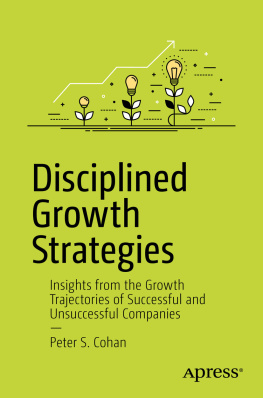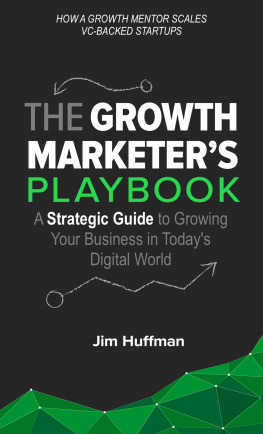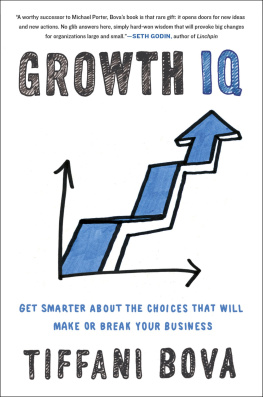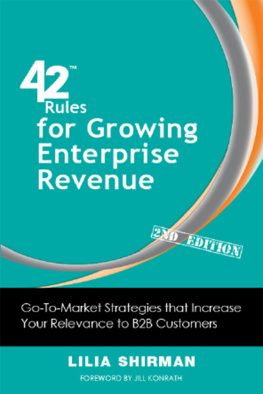1. Introduction
One of the most important challenges that leaders face is to devise and execute strategies that speed up revenue growth. Not growing fast enough can be costly for executives and investors. Take the example of LinkedIn, the business social network service. After markets opened on February 5, 2016, investors hacked 44% from the companys shares. The reason was easy to understand, yet difficult to remedy. LinkedIn lowered its expectations for the years growth in revenue (from 35% to 20%) and adjusted earnings (from 41% to 7%)well below what analysts expected. This slashed a cool $1 billion from the net worth of LinkedIns founder, Reid Hoffman, and forced its CEO, Jeffrey Weiner, to ponder important questions that must be answered before investors could hope to recoup what they had lost.
Where would faster growth come from? Could it be spurred by improving LinkedIns offerings? By selling its current products to new customers, or in new geographies? By inventing new products for its existing customers? By adding entirely new classes of products, or creating a new growth culture? Ultimately, LinkedIn failed to answer these questions. On June 13, 2016, Microsoft paid a 50% premium over the previous days price$26.2 billionto acquire LinkedIn. The deal restored LinkedIn shareholders to where they were before that fateful February day. And it let Weiner off the hook. He was no longer under pressure to conceive and implement an effective growth strategy for LinkedInthat would become the responsibility of Microsoft CEO, Satya Nadella.
LinkedIns growth challenge was just one side of the growth coin. The other is growing too fastin a manner that boosts short-term revenues and stock price but is ultimately unstainable and leads to collapse. A case in point is Laval, Quebec-based pharmaceutical manufacturer Valeant Pharmaceuticals . Former McKinsey consultant Michael Pearson advised Valeant as an outside consultant in 2007and took over as its CEO in 2008. In the seven years that followed, Pearson cut risky R&D (research and development) and made acquisitionsdrastically raising the prices of its existing approved drugs. The result was a more than 1,000% spike in Valeants stock price through early 2015winning Pearson a $1 billion fortune. Valeant fell apart in September 2015 when its drug pricing policies came under attackslashing 90% from the stocks 2015 peak value. Pearson was dismissed from Valeants CEO slot. While LinkedIns disappointing growth demonstrates the challenges that face executives who cant achieve enough growth, Valeants implosion shows the high price that leaders pay for growing too fast with a strategy that cant be sustained.
The unfortunate truth is that very few executives can think of creative, practical solutions to such questions. To me this suggests a crying need for growth discipline. By this I mean a systematic process for brainstorming, evaluating, choosing, and implementing growth strategies that produce the kind of better-than-expected revenue and profit growth that boosts shareholder valueand makes it easier for leaders to attract and motivate top talent.
Why Growing Faster Matters
Growth creates opportunities for your people to develop their skills. It attracts the best talent to your company (and away from rivals), and it creates wealth for you and your investors. Moreover with the world economy struggling to grow at all, start-ups and public companies are increasingly falling into two categoriesthe vast majority that are stagnating and declining, and a tiny minority that are enjoying accelerating growth. Languishing public companies become fodder for so-called activist investors who buy a small stake, lobby hard for splitting the company into pieces, and clamor for board seats.
Consider the case of DuPont . In 2014 , veteran activist investor, Nelson Peltz, bought a 2.7% stake in the chemical conglomerate and demanded that it break itself into pieces. While Peltz lost a proxy battle in May 2015, he won the war in October 2015 when DuPonts CEO, Ellen Kullman, resigned under pressure after a 46% drop in quarterly profits from the year before. Ultimately, Peltz got a split upbut not in the form he wanted. In December 2015, DuPont and Dow Chemical merged at a value of $120 billion with the idea that they would cut $3 billion in costs and two years later split into three public companies focusing on agricultural, materials, and so-called specialty products .
For top executives, such interventions are hugely distracting and often career ending. The desire to avoid such distractions should spur CEOs to lead their companies to much faster growth that boosts their stock price to a level that makes it harder for activist investors to flip for a quick profit. Shrinking private companies are even more vulnerable. Chances are good that they will not attract investment, will burn through their remaining cash, and shut down. Simply put, boards must ensure that their CEO is achieving rapid growth or has a compelling plan to deliver it. Otherwise, they should find a CEO who can.
Growth Challenge Varies by Company Size and Growth Trajectory
Growing faster is always a difficult challenge.
However, as illustrated in Figure , the nature of that challenge varies depending on the size of the company and its growth trajectory.
Figure 1-1.
Growth Challenges by Company Size and Growth Trajectory
Here are examples of each:
SimpliVity (small, growing). This Westborough, Massachusetts-based data storage supplier had grown to nearly 800 employees by December 2015 with revenues increasing 50% in the third quarter of 2015. By November 2016, SimpliVitys CEO, Doron Kempel, faced three challenges. Its biggest partner, Cisco Systems , was building a product to compete with SimpliVitys. Its larger rival, Nutanix, had gone publicraising significant capital that it could invest in sustaining its market lead. And SimpliVity was so eager to raise newbut its stock had since dropped considerably. Capital that rumors surfaced that it might be acquired for as much as $3.9 billion by Hewlett Packard Enterprise (HPE) . In January 2017, HPE acquired SimpliVity for a disappointing $650 million in cash.
Fiksu (small, declining). This Boston, Massachusetts-based mobile app marketing algorithm developer had grown from less than $1 million in 2010 to $100 million in a mere 3 and one-half years with only $17.6 million in venture capital. But in 2015, Fiksu hit the wall. As that year dawned, Fiksu was planning to double staff to 500 and go public. Yet by April 2015 it had called off its IPO and announced plans to fire 10% of its staff. By September 2015, it had dismissed 25 more people. Intense price competition from better-funded rivals slammed the brakes on Fiksus growth. Micah Adler, Fiksus MIT-educated CEO, hoped to revive the companys growth by applying its algorithm-development skills to a new market analyzing consumer data to help advertisers target more effectively. However, by March 2016, Fiksu was quietly folded into another companya disappointing result for its investors. Adler said, Eighty-five cents of every new online advertising dollar goes to Google and Facebook. Its harder and harder for small companies to compete.
Amazon (big, growing). Seattle-based Amazon is a $100 billion e-commerce and cloud service provider that continues to grow at over 20% annuallydespite earning barely perceptible profits. Since it needs to add over $20 billion in revenues to sustain that pace, Amazons CEO Jeff Bezos faces a huge challenge in sustaining that growth. Can he invest in the right blend of new services, new capabilities, and new geographies to sustain that 20% growth?








